|
==============================================================================
TOPIC: Baxter Creek
http://groups.google.com/group/entstrees/browse_thread/thread/3ee964766c28aa09?hl=en
==============================================================================
== 1 of 3 ==
Date: Sun, Jun 8 2008 6:04 pm
From: dbhguru@comcast.net
ENTS,
In April at the ENTS rendezvous in Black Mountain, North Carolina,
the group of us staying at the boy scout camp split up and went on
separate field trips. Monica, Ed, and I went to Baxter Creek in the
GSMNP to view wild flowers. None of us were up to slashing through
the rhododendron hells that faced the others on a companion trip. I
also wanted to remeasure the Rucker tuliptree, presently awarded the
title of tallest tuliptree known. The Rucker tulip had a very bad
last year and I wanted to see what kind of damage it had suffered -
hopefully minimal or none.
In addition to tall tuliptrees, the Baxter Creek area is known for
the extravagent display of its spring wild flowers, and I'm pleased
to say that the site didn't disappoint us. From the parking lot, it
is a fairly short walk into the area of super tall tuliptrees, which
was just fine for the three of us on that particular day. For my
part, my sciatic pain was letting me know that I would pay for any
heroics.
No sooner had we departed our vehicle and crossed Big Creek than we
encountered impressive displays of spring flowers. The flower
spectacle was the principal reason Monica had wanted to attend the
rendezvous - that and to reacquaint herself with the Blue Ridge
Parkway. I wasn't worried that she would be disappointed, and I do
think the abundance and luxuriance of the Baxter Creek flower show
met her expectations. Maybe she will say a few words on her
impressions of Baxter Creek at some future point. She had a special
tuliptree moment on our way back when she experienced the ambience
of a grove of young, arrow-straight tulips with their bright green
foliage. Monica is very sensitized to natural beauty and can tune in
to the essence of a place, especially if there is water close by.
I'm accustomed to her pausing to catch the soothing babble of a
mountain stream. Her trained musical ear catches more than mine and
puts her into a trance-like state. I think Baxter Creek satisfied he
r need for the sound of water flowing over rocks.
By the time we finished our trek, we had identified 42 species of
wild flowers, many in large patches. Many were the typicals such as
false solomon's seal, several species of violets, etc. I can't show
them all, but would like to give everyone an idea of what we saw.
Below are several of Ed's photos showing some of the more impressive
flowering spectacles.
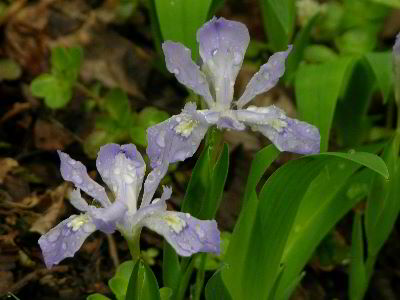
Crested dwarf iris
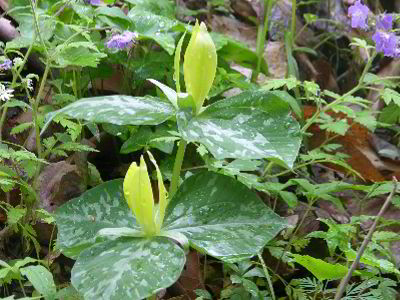
Yellow trillium

Purple fringed phacelia

Doll's eyes

Trillium erectum (white form)

Composite
Anyone who walks the trails of the Smokies in different seasons and
at a range of elevations can attest to the abundance and variety of
flowers. The Smokies are called the jewel of the Appalachians for
good reason. However, on any given outing, one sees only a tiny
sample. On that April day, we saw what was blooming at low
elevations. I wish we had had the time and energy to climb up into
the more northerly forest types. The trail runs for 6 miles and
climbs to the top of Mount Sterling at a lofty 5,842 feet. The climb
from the trailhead gains a whopping 4,000 feet of elevation, one of
the greatest climbs in the East. That climb will have to wait for
another day. On our day, 400 feet elevation gain seemed like a lot.
There are many observations one could make about the attractive
features of the Baxter Creek trail. To name a few, there are, of
course, the towering tuliptrees, the lavish displays of spring wild
flowers, the exotic combination of big and small leaf plants, and
picturesque Baxter Creek itself. But simple lists of superlatives
never do the Smokies justice. The peaks create a gestalt that must
be experienced in its totality to be fully appreciated. One cannot
be over- focused one one or two features as so many visitors are.
Clouds on the high peaks, mist in the coves, the ambience created by
a truly superlative, tall canopy forest all create a timeless
feeling in those mountains that transcend individual features. With
my focus on tall trees, I'm preaching to myslef as earnestly as to
those who only see the flowers, hear the birds, or just mindlessly
hike for distance.

I did succeed in remeasuring the Rucker Tuliptree, but couldn't get
over 177.5 feet. An average of multiple shots would have been around
177. Very likely, Colby's poplar can no longer lay claim to the
tallest of its species that we know about. Yet, that hardly matters.
It certainly wouldn't have mattered to Colby. Besides, the cove
where Colby's tree grows in combination with a cove or two beyond
sports a dozen or so 170-footers. I have forgotten the exact count,
but I think Baxter Creek still holds the record for the most
170-footers.
If there is a sour note in any of this, it is the poor record of the
GSMNP in presenting its superlative trees to the public in such a
way as to get the message across that among eastern forests, the
Smokies truly rule.
Bob
== 2 of 3 ==
Date: Sun, Jun 8 2008 6:17 pm
From: James Parton
Bob,
I gotta make it to Baxter. I have not visited it yet. It sounds
impressive.
What is the current height holder for Tuliptree? Where is it?
James P.
== 3 of 3 ==
Date: Sun, Jun 8 2008 7:04 pm
From: Gary Smith
Bob/ENTS,
177 feet is still SO impressive for any tree in the East, most
likely
a good 35 feet higher than anything I've ever seen in the deep
South.
I wonder what the general consensus among the cognoscenti is as to
the
maximum heights tulip trees and eastern white pine were in pre-
settlement days....190-200 ft perhaps?
gs
==============================================================================
TOPIC: Baxter Creek
http://groups.google.com/group/entstrees/browse_thread/thread/3ee964766c28aa09?hl=en
==============================================================================
== 2 of 7 ==
Date: Mon, Jun 9 2008 5:40 am
From: dbhguru@comcast.net
James,
I think the official record holder is still the Rucker, by maybe
inches. Jess and Will know of contenders though and at least one
other tuliptree reaches 177 feet.
Bob
== 4 of 7 ==
Date: Mon, Jun 9 2008 6:36 am
From: "Gary A. Beluzo"
ENTS:
For my images of the Smokies this past April and also 3 videos (2
bear
and 1 deer) go to www.gallery.mac.com/garybeluzo. Try the carousel
mode for the images...SMOKIES RULES!!
Gary
== 5 of 7 ==
Date: Mon, Jun 9 2008 6:08 pm
From: "Will Blozan"
Bob, Gary, James, etc.
Jess found a tuliptree on Big Fork Ridge, NC-GRSM that we carefully
measured
to 177.6 feet on 3-14-2007. It was an old-growth specimen 14'9"
in girth.
However, Jess has also found one near Smokemont, NC that may be
closer to
179 feet. He had one shot ~180'. This tree is on the top of a fall
measurement list! I saw the 177.6 footer three weeks ago and it is
looking
good. The frost last year probably resulted in no net growth but
this fall
it will be revisited as well.
Basically, the champ is undecided. There is also a super thrifty
tree on Big
Creek that I last had at 177.1 feet in 2005. Another young tree on
Mouse
Creek, NC-GRSM growing on a railroad bed was over 174 feet in 2004.
Some
ENTS needs to come over this Fall for a detailed measurement of all
the
contenders.
Will
== 6 of 7 ==
Date: Mon, Jun 9 2008 8:07 pm
From: James Parton
Will,
179-180? Cool! Smokemont? I have heard of it. Where is it located in
NC?
JP
== 7 of 7 ==
Date: Mon, Jun 9 2008 8:11 pm
From: "Edward Frank"
Bob,
Excellent report. I enjoyed the hike very much. Thanks for inviting
me along. I am still not sure of the species of some of the flowers
I photographed. Too bad the silverbell photos did not turn out
better. [Identifications by Jess Riddle below - Bob and Monica
Leverett identified them using a field guide while hiking, but I
missed getting a copy of the ID's.]

fernleaf phacelia (Phacelia bipinnatifida)

fernleaf phacelia (Phacelia bipinnatifida)
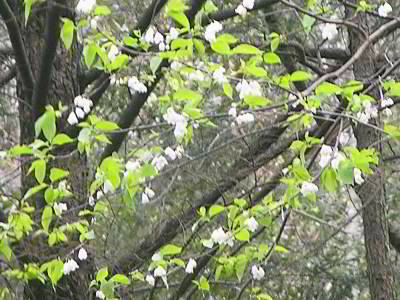
Silverbell

false solomons seal a.k.a solomons plume (Maianthemum
racemosum),
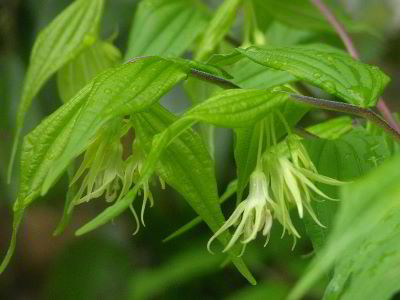
yellow mandarin (Prosartes lanuginosa)
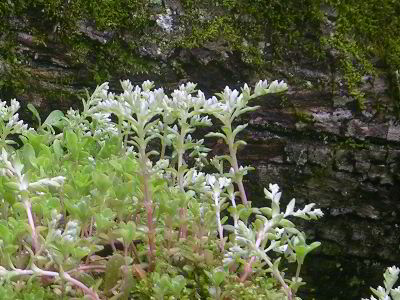
stonecrop (Sedum ternatum)

giant chickweed (Stellaria pubera)

resurrection fern (either Polypodium virginianum or P.
appalachianum)
==============================================================================
TOPIC: Back to Gary Smith on historic tree heights
http://groups.google.com/group/entstrees/browse_thread/thread/ab4ba16ea1aeecc9?hl=en
==============================================================================
== 1 of 2 ==
Date: Mon, Jun 9 2008 5:35 pm
From: dbhguru@comcast.net
Gary,
Numbers like 200 feet have been tossed around for the tuliptree as
having been historically achieved and I even read quotes of heights
in that range today. We have not been able to verify even 180 feet
although I think it is just a question of time. I personally believe
the absolute limit of the species lies between 180 and 190 feet, but
I have no way of proving it.
White pines are touted to have grown to heights in excess of 260
feet in colonial times. I've seen 264 feet listed. That's the
highest number I've seen in print. However, there is no reason to
believe such claims. What can we believe? I expect that a few
Pennsylvania whites and some in North Carolina, Tennessee, South
Carolina and Georgia topped out at between 210 and 220 feet - but
darn few. Trees in that height class would have been on the extreme
tail of what is a heavily skewed statistical distribution.
A large part of the ENTS mission is to determine legitimate species
maximums. That is a big part of what is driving our efforts to
engineer better field measurement techniques and to spread our
knowledge around. As I have often stated, "it ain't rocket
science, folks." However, winning converts has been
surprisingly slow. If money were involved and people had to pay up
for being wrong, we'd see converts to our methods by the scores. But
shy of putting money down, progress will remain a foot at a time.
Bob
== 2 of 2 ==
Date: Mon, Jun 9 2008 7:50 pm
From: Gary Smith
Bob,
Thanks for getting back with the answer to my question. Eastern
white
pine does not naturally occur down my way, but I sure hope to see
some
hemlocks and whites this September.
ENTS definitely has a worthy mission. Maybe the 2/09 Congaree
expedition will make for a major break through on the "winning
converts" issue.
Gary S.
==============================================================================
TOPIC: Baxter Creek
http://groups.google.com/group/entstrees/browse_thread/thread/3ee964766c28aa09?hl=en
==============================================================================
== 1 of 3 ==
Date: Wed, Jun 11 2008 8:35 am
From: "Jess Riddle"
Ed,
The first two shots are fernleaf phacelia (Phacelia bipinnatifida),
the fourth photo is false solomons seal a.k.a solomons plume
(Maianthemum racemosum), the fifth is yellow mandarin (Prosartes
lanuginosa), next is stonecrop (Sedum ternatum), then giant
chickweed
(Stellaria pubera), and finally resurrection fern (either Polypodium
virginianum or P. appalachianum, I can't tell).
Jess
== 2 of 3 ==
Date: Wed, Jun 11 2008 10:14 am
From: James Parton
Jess,
Thanks for the ID's. I will remember this.
Resurrection Fern also grows on trees like Live Oak? Right? I saw
ferns like these growing on a large Post Oak in SC.
James Parton.
== 3 of 3 ==
Date: Wed, Jun 11 2008 6:17 pm
From: JamesRobertSmith
I love the Baxter Creek section of the park. I've hiked up to
Sterling
and along Sterling Ridge a number of times. Just over the ridge down
in Raven Fork is probably one of the prettiest and least accessible
parts of the park I've ever backpacked.
That's a nice climb--have you ever done the mile-high from
Gatlinburg
city limits to the summit of LeConte? That's a real chore! I did it
in
March 2005. I think I'm right in saying that it's the only vertical
mile hike on the east coast.
|